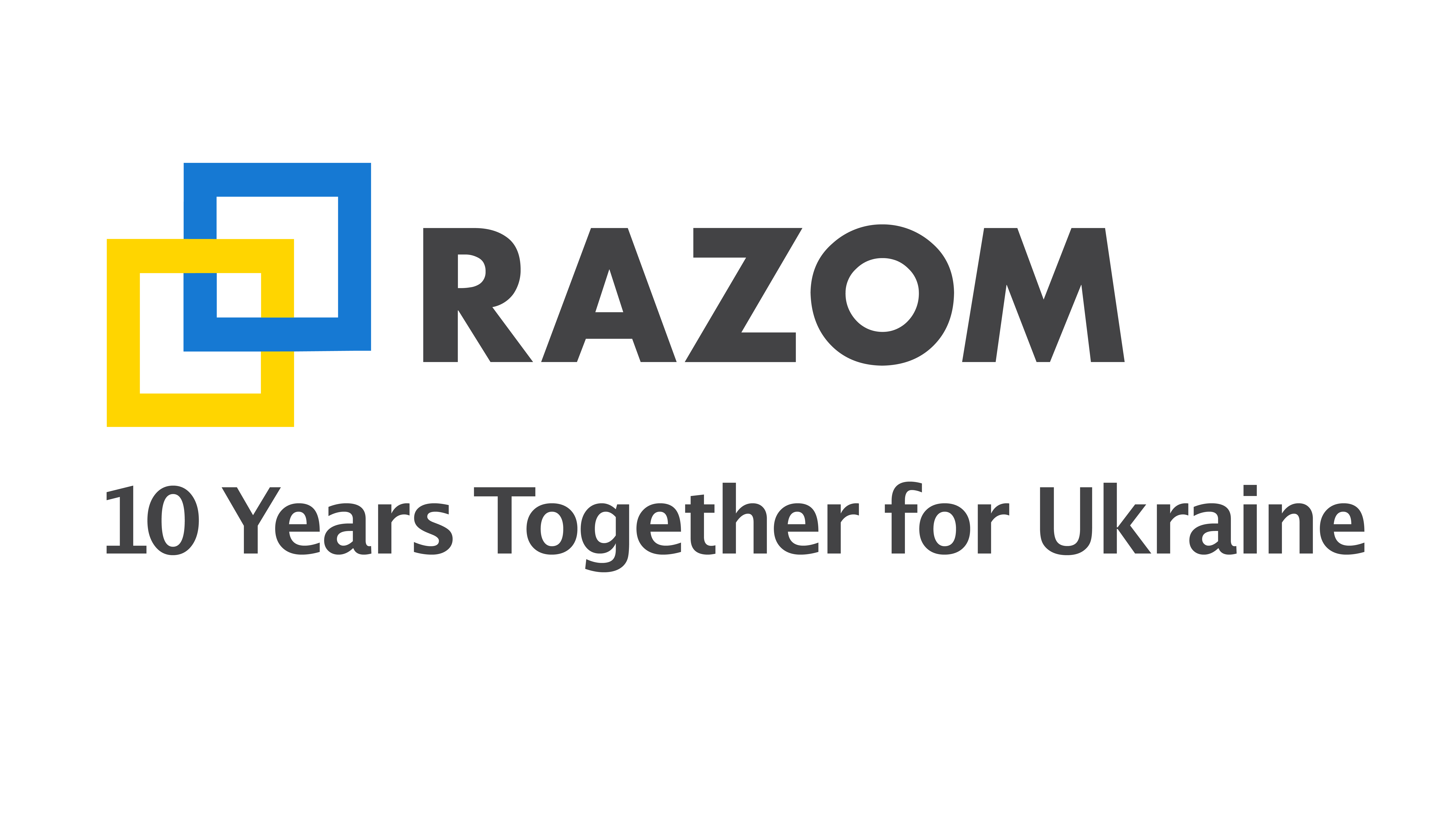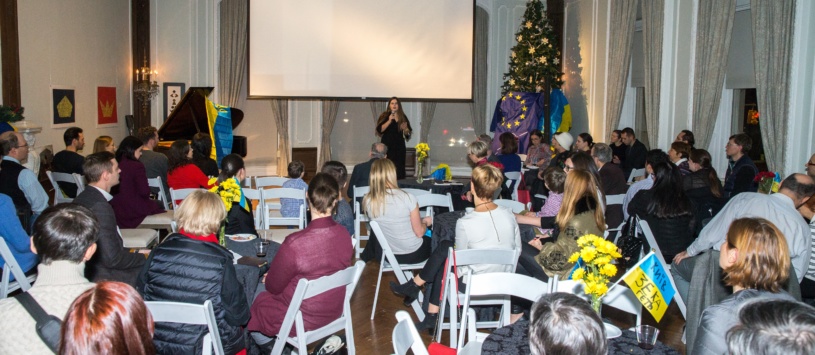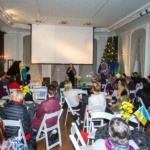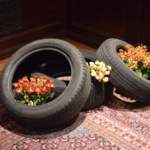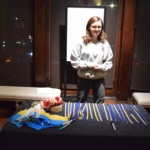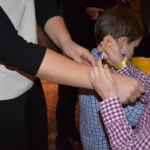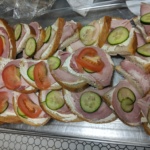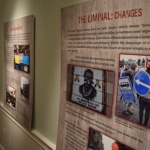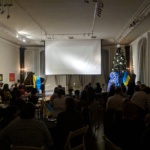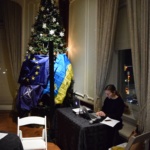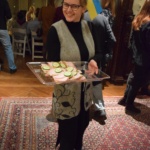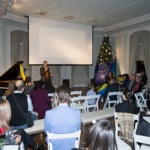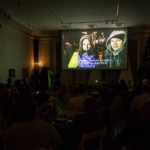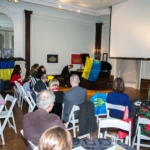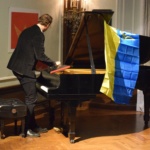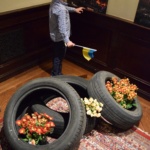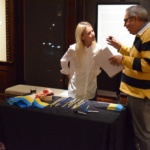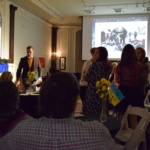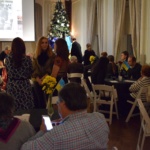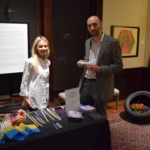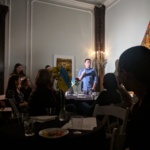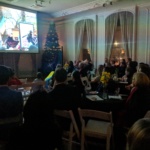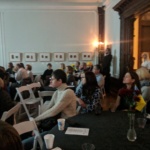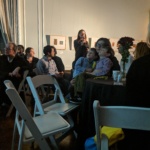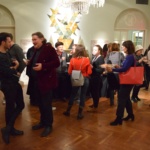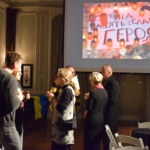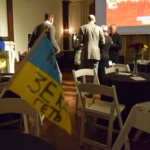In early December, Razom volunteers co-hosted an event with the Ukrainian Institute of America in New York City, marking the five years since the Ukrainian revolution began. The purpose of the event was to bring people together to share their own stories of how Maidan affected them in the year of 2013 and onwards. “Our question here today is ‘where were you in the winter of 2013? Who were you and how did Maidan change you?’”, said Maryna Prykhodko, one of the MC’s, as she welcomed the audience.
The evening began with a brief reception, where guests mingled and previewed images and accounts of Maidan, displayed on posters throughout the hall. Ukrainian kanapés, wines and cheeses were served, as well as kovbasa and pierogies (varenyky) generously donated by Bachinsky East Village Meat Market and Veselka. Guests were ushered into the darkened main hall, where Prykhodko and her co-MC Roman Ozimko introduced a brief history of the Revolution of 2013-2014, followed by a piano performance by Alex Pryrodny, a Ukrainian-American jazz pianist and composer.
The venue was cleverly designed under the art direction of Kasia Zabawka to feel like the Khreschatyk during the revolution, with iconic symbols from Maidan: the hot chai served in paper cups, like that served during cold nights in Independence Square; the Yalynka (Christmas tree) adorned with both the European Union and Ukrainian flags; a pile of tires, reminiscent of the constantly burning tires on Independence Square at the time; a piano covered in a Ukrainian flag, representing the iconic blue-and-yellow painted piano that became a symbol of positivity during Maidan.
One by one, Razom members shared their stories of their experiences from that time, and how it impacted their life afterwards. Mariya Soroka, President of Razom, shared a touching story of her week-long trip to the Maidan, seeing her father for the first time in 8 years, and hand warmers. She described her impulsive decision to book a flight to Maidan, followed by a single purchase before her trip: hand-warmers, so she could hand them out on Independence Square to all the brave people who spent their days and nights there. Mariya described the aura on Maidan. “It felt like a utopia. […] I learned that Maidan was in fact the safest place in Ukraine at that time. I wanted to live there. To live in a tent, drink the tea and eat kanapkas every day. I shared all my hand warmers.” For Mariya, Maidan changed her perspective on family, and initiated her drive to constantly work on helping Ukraine. After Maidan, she promised her father she would come and visit him every year. Mariya entered Maidan with a box of hand warmers, and left with a new purpose in life. “[…] Because of that trip, my life definitely changed. For me it was my relationship with my dad, my purpose in life. I realized that no matter what I am doing I will do something to make Ukraine a safe, democratic, and prosperous country.” After Mariya returned to the U.S., with this newly fueled passion, she co-founded Razom for Ukraine.
Anna Shpook, a co-founder of Razom, said, “Many Maidans were happening all over the world including on the streets of New York City.” In 2013, she and other Ukrainian activists rented a sightseeing bus to spread information about the revolution to Americans and tourists in NYC. Most of the speakers who participated in the Maidan in Kyiv continued to advocate for Ukraine after coming to the United States.
Kateryna Lisunova, who currently works as a journalist covering the United Nations in New York, described her experience as a 17-year old young woman on Maidan. She recounted an endearing episode, where she gained a liking for a young man on Maidan, and didn’t want to leave the tent city one night because she enjoyed his company. She promised him she would be back the next day, and they said goodbye. That night was January 21st, the night of the first shootings on Maidan. The young man she described was Serhiy Nigoyan, who she soon found out was killed by snipers. Kateryna’s story was one of sorrow and loss, emotions that were felt by many throughout this time.
A quite humorous story was told by Dr. Tina Goloborodko, an Odesa native who grew up never having had a conversation with a Ukrainian speaker, and believing that Ukrainian-speakers were out to get Russian-speakers. Tina, too, decided to go to Maidan during the revolution, to experience this historical moment and stand by the Ukrainians, whether Ukrainian-speaking or Russian-speaking. Maidan and her later experiences in working towards improving Ukraine, proved to her that Ukrainians can come together across an arbitrary language divide, and have a greater impact when working together. “To me, Maidan was about cultural revelation. […] To me, Maidan was about unity. My dream is that Ukraine will truly feel united, that there won’t be language issues. No one will worry about their language, no one will worry about their identity, we will all feel equally Ukrainian, we will all feel equally proud, we will all feel equally dedicated to this beautiful country which I endlessly believe in”.
Each story was different; some were dramatic, some heartbreaking, some heartwarming, and even humorous. They were truly representative of the diverse events experienced during Maidan. As the night progressed, guests reminisced about the live feeds they watched all day at work, the Automaidans that took place in the U.S., the sleep that was lost over anxiety about Maidan, and the mix of emotions that was endured during this unpredictable time. Between each story, video clips from Maidan were screened, reminding viewers what the revolution looked, felt, and sounded like. “Five years is enough time to start forgetting, and watching the videos, I realized I did start forgetting how beautiful it was and how inspiring it was,” Dr. Tina Goloborodko said. In the final video, participants watched thousands of Ukrainians in Independence Square singing their national anthem, remembering the magnitude and optimism at the start of the revolution.
To honor the victims of The Nebesnia Sotnia (Heavenly Hundred), the hosts passed around candles and led the audience in a moment of silence. A panel discussion followed, where a former Deputy Ministry of Education Inna Sovsun, as well as Tymofij Mylovanov, the President of Kyiv School of Economics, discussed their experiences then and now in Ukraine, and how Maidan changed the country. The night gracefully ended with the song “Plyve Kacha”, a classic folk song that took on new symbolism at the Maidan, when it was sung almost every day, as a tribute to the fallen.
The atmosphere and emotions that evening were truly reminiscent of the winter of 2013-2014. Much like the revolution itself, Razom’s event brought together a wide variety of people, young and old, native Ukrainians, Ukrainian diaspora, non-Ukrainians, Ukrainian-speakers, Russian-speakers, and English-speakers. One thing united these people; they all felt a deep connection to the Maidan, and its purpose, in their own way.
By Uliana Bilash and Maya Lucyshyn
